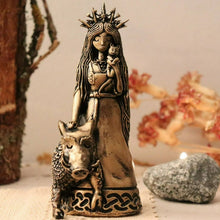

Handmade in Estonia

Made from eco plant-based resin

Comes with an info sheet about the festivity

Height: 13 cm / 5 inch
Width: 6 cm / 2.3 inch
Weight: 160 g / 5.6 ounces
Width: 6 cm / 2.3 inch
Weight: 160 g / 5.6 ounces

Handmade in Estonia

Made from eco plant-based resin

Comes with an info sheet about the festivity

Height: 13 cm / 5 inch
Width: 6 cm / 2.3 inch
Weight: 160 g / 5.6 ounces
Width: 6 cm / 2.3 inch
Weight: 160 g / 5.6 ounces
Freya, daughter of Njord and Herta (Nerthus), Sea and Earth, is among the Vanir hostages who joined the Aesir to maintain spiritual peace. Freya, however, quickly became a dominant force in her new realm. When she first arrived in Asgard, she taught the Aesir how to craft charms and potions. She inducted Odin into the world of magic.
Freya is invoked for love, romance, and fertility, but she is a death goddess, too. Under the name Valfreya, she leads the Valkyries to the battlefield where she lays claim to half the dead who are brought to dwell in her beautiful palace, Folkvang, where love songs play continuously.
Freya was no obscure goddess but beloved and worshipped over a vast European territory including Scandinavia, Iceland, Greenland, the Germanic lands, Holland, and Anglo-Saxon Britain. She remains among the most beloved and widely venerated Pagan goddesses today. No spirit annoyed Christian authorities more than Freya. Ironically, the result was that Freya survives more vividly than virtually any other female European spirit. Constant condemnation kept Freya from fading into obscurity.
Freya was denounced as a Queen of Witches. Women who venerated her were automatically branded “witches.” And, of course, Freya’s rites and traditions did encourage magical practice, mediumship, shamanism, and female autonomy with Freya herself as the role model, behaviour the new regime considered abhorrent and sinful.
• Freya weeps tears of amber.
• Honey contains her essence.
• Freya knows the power of the runes. They can be used to communicate with her.







